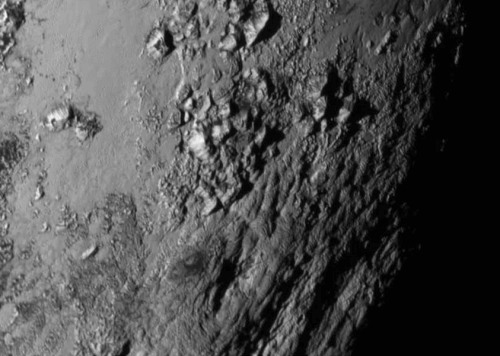The first images broadcast by the New Horizons spacecraft after the flyby of Pluto apparently indicate geological activity that continues even now

Close-up images of an area near Pluto's equator (and near the famous "heart") revealed a huge surprise: a chain of young mountains rising 3,500 meters above the surface of the dwarf planet.
"These mountains were almost certainly formed no more than 100 million years ago, a blink of an eye compared to 4.56 billion years - the age of the solar system, and it is possible that they are still in the process of being built." says Jeff Moore of the New Horizons Geology, Geophysics and Imaging team. This likely indicates that this area, roughly covering less than XNUMX percent of Pluto's surface, may still be geologically active today.
The assumption of Moore and his colleagues about the young age of the mountains is due to the lack of craters in the area. As with the rest of the surface of the planet Pluto, this area has been bombarded by fragments from space for billions of years and would have been full of craters unless fresh activity gave the area a facelift and erased the signs of age. "This is one of the youngest surface orbits we've ever seen in the solar system," says Moore.
Unlike the icy moons of the major planets, Pluto cannot be heated by interactions with a much larger planetary body. Therefore, other processes must have created the mountainous landscape. This may cause us to rethink the activity of geological forces on many other icy worlds" says deputy director of the geology and geophysics team and professor at the Southwest Research Institute in Boulder, Colorado.
The mountains are apparently made up of Pluto's 'bedrock' which is mainly composed of water ice. Although the surface of Pluto is covered with methane and nitrogen in a solid state of accumulation (ice), these materials are not strong enough to build the mountains. Therefore a harder material, most likely water ice, is needed to form the peaks. "At Pluto's temperatures, water ice behaves more like rock," says another GGI team member Bill McKinnon of Washington University in St. Louis.
These close-up photos were taken about an hour and a half before the point of approach to Pluto, when the spacecraft was 77 km from the surface of the planet. In the picture you can see details that are about a kilometer wide.
Spectroscopic data from the Ralph instrument aboard New Horizons revealed large amounts of methane ice, but its distribution is uneven.
Charon
Charon also provided similar surprises, a chain of young mountains and a variety of landscapes. The scientists were surprised by its craterless appearance. A strip of craters and depressions stretching for about a thousand kilometers, indicates an extensive crack in Charon's crust, most likely as a result of an internal geological process.
The photo also shows a canyon whose depth is estimated at 7-9 kilometers. In the north pole area of Charon there are dark areas where the border between them and the light areas is blurred, which indicates a thin layer of stain on the surface.
Hydra
New Horizons also observed the smaller members of the Pluto system and four other moons – Nix, Hydra Styx and Cerberus. A quick image of Hydra is the first to reveal its irregular surface and its size - 43 by 33 kilometers.
The observations also indicate that Hydra's surface is most likely covered in water ice. Images that will be transmitted in the future will reveal more clues about the structure of this moon and the other moons.
"The New Horizons spacecraft exploring Pluto is a real discovery mission that shows us why it's important to do basic research," says John Grunsfeld, NASA's deputy director for science missions at the agency's headquarters in Washington.
"It took New Horizons nine years to build the expectations of what we could see on the approach flight to Pluto and Charon. Today we receive the first example of the scientific treasures collected during these critical moments and I can say that they surprise and exceed expectations"
"Gate" says Alan Stern, principal investigator of the New Horizons mission at the Southwest Research Institute in Boulder, Colorado. "New Horizons has already sent us amazing pictures. The data looks amazing.”
For a message on the NASA website
More on the subject on the science website"
- New Horizons "phoned home" to announce that it survived the transit near Pluto * The photos will arrive in a trickle over the next year and a half
- Images of Pluto and Charon taken by New Horizons in artificial colors highlight the enormous variety of terrain trajectory on these two worlds
- NASA is celebrating the passage of New Horizons at the closest point to Pluto and is waiting to renew contact with it early in the morning
- Technion researchers have proposed a model for finding new moons for Pluto, awaiting New Horizons photographs
- New Horizons revealed: Pluto's diameter is 2,370 km
- New Horizons approaches Pluto - photographed the enigmatic dark spots
- Discoverer of Pluto, the girl who gave him his name and the actor Leonard Nimoy will be commemorated on Pluto and Charon
- A historic meeting
- A whale on Pluto
- Pluto - a point of light in the darkness

2 תגובות
Luckily we have a new horizon and the sky is not the limit
There was someone here who complained about the quality of the pictures. ..